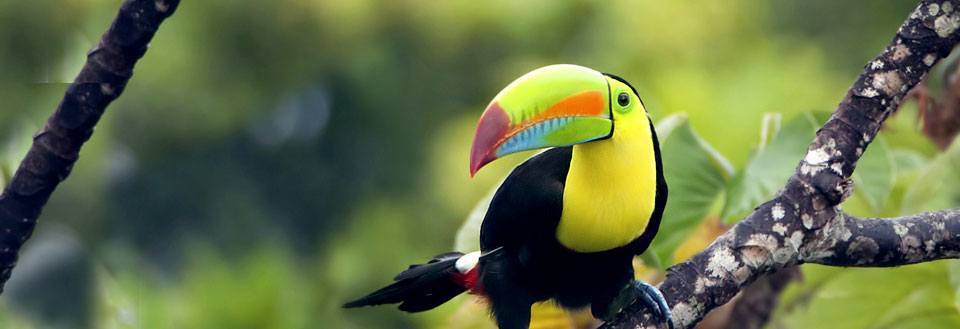Costa Rica (the rich coast) is Central America's 'special jewel'. Whilst the surrounding countries of Nicaragua and Panama are rather turbulent, Costa Rica is a quiet, peaceful country with wonderful natural scenery and a remarkably varied wildlife. Quite aside from this Costa Rica owns some of the best beaches of Central America - perfect if you like surfing or just want to relax by the sea.�
República de Costa Rica
San José (250.000)
51.060 sq km
Spanish
Roman Catholic
3.533.000 (1999)
Republic
With the exception of El Salvador, Costa Rica is the smallest country in Central America. It is long and narrowly shaped, with the Pacific in the west and the Caribbean in the east. Nicaragua is its northerly neighbour and Panama is found to the south. The country is a vibrant green and possesses an abundant tropical climate (and so also a rainy season).�
Concerning climate - late-December to mid-April is the best time for a trip to Costa Rica because it is the dry season. Higher hotel-prices and more tourists are the unfortunate downside to this. It is much quieter during the rest of the year - when you also get a far cheaper (though wetter) experience. �
Lonely Planet Costa Rica
Explore Costa Rica
Colón (CRC)
Costa Rica has quite a lot of Internet cafes placed in the large and medium-sized cities. The cafes are usually cheap and some of them are even connected with a bar and a cafe.
To call for help in Costa Rica you dial 911 for the police, an ambulance or the fire department
Tipping is not common in restaurants, as a service fee is added to the bill.
Piccolos in more expensive hotels expect about 100 colones a bag, and guides expect 300-400 colones a day.
When it is noon in England, it's 6 a.m. in Costa Rica.
Weight: kilo
Length: metre
In some instances the old Spanish units of measurement have survived. Sometimes length is given in 'varas' in directories. 100 varas equal 83 centimeters.
�
Photography presents no problem in Costa Rica, though you should be aware of any special rules when visiting holy places, just as you should not take photos of individuals without their express permission.�
In the major cities it is safe to drink water from the tap, but it does have a lot of chlorine in it. Outside the major cities you should either buy bottled water or boil the tap water - but the former is the safest.�
110/220 volt
AC/69 Hz
For most occasions it is fine to wear informal clothes, but beachwear is for the beach only. If you are invited into someone's home it is good manners to bring your host a gift. The term Dona is used before a woman's name, and Don before a man's.�
Banks are open form 9.00 to 15.00 (Monday to Friday).
Shops are open from 8.00 or 9.00 to 17.00 or 18.00 (Monday to Saturday). Most shops close for lunch between 12-13.
The Costa Rican food is simple, with rice and beans as the preferred ingredients and the core of most meals. Gallo Pinto is a national dish consisting of fried rice and black beans. The rice is sometimes served with chicken flesh (arroz con pollo), and the national drink of Costa Rica is of course coffee - do try the 'grano d'oro'.�
Even though disabled travellers are rarely taken into consideration in Costa Rica, you can expect that people are friendly and very helpful if there are any problems getting around. That said, you should probably go on a pre-arranged tour to Costa Rica instead of travelling on your own.�
New Year's day, 1 January.
Saint Joseph's Day, 19 March.
Juan Santamaria's Day, 11 April.
Labour Day, 1 May.
Annexation of Guanacaste, 25 July.
Virgin of Los Angeles Day, 2 August.
Mother's Day, 15 August.
Day of Independence, 15 September.
Colombus Day, 12 October.
Immaculate Conception, 8 December.
Christmas Day, 25 December.
Shifting holidays
Easter Day, end of March or beginning of April.
Good Friday, end of March or beginning of April.
Whitsunday, beginning of June.
Camping sites are not exactly plentiful in Costa Rica, but tourists are often seen camping on the beaches. Several of the national parks also have camping facilities, and camping sites at the popular destinations are starting to appear.
Costa Rica has a variety of hotels in all price ranges. The cheapest ones only have the absolutely necessary furniture but are both clean and quite good, whereas the few luxury hotels in the country really live up to their reputation.
The number of Bed&Breakfasts is increasing in Costa Rica, and many Costa Rican families will open their homes to tourists in exchange of a modest payment.
Hostels are practically non-existent in Costa Rica, but since the pensions and hotels are so cheap it wouldn't be worthwhile staying in a hostel anyway.
Cheap pensions, "cabinas" at the beaches and small huts in the jungle and mountains are just a few of the many inexpensive options for overnight accommodation that can be found in Costa Rica.�
There are two airlines (SANSA and Travelair) with daily domestic flights, but it is necessary to book well in advance.
From San José buses go to all parts of the country. The bus system can be chaotic and uncomfortable, but it's cheap.
There are no trains in Costa Rica.
Taxies are often used for extended trips as it's cheap, and many people rent a taxi for an entire day.
Cars and motorcycles can be rented in San José.
There are many advantages to going to Costa Rica in the rainy season between the end of April and the end of December. You shouldn't feel intimidated by the fact that many roads close during this period, and that this makes it difficult to reach some regions, because the advantages are so many: The country is incredibly green, the prices drop drastically and you can pick and chose any hotel you want.
